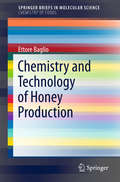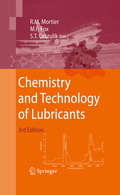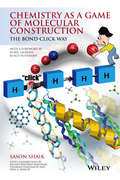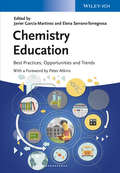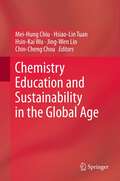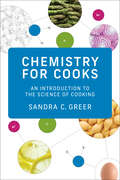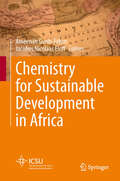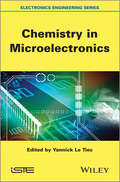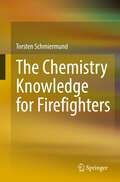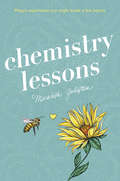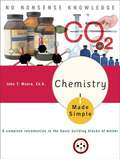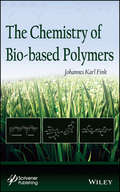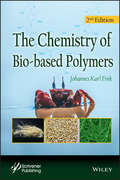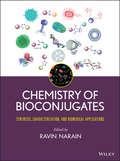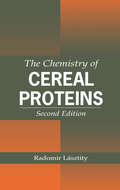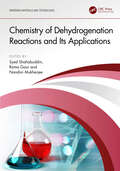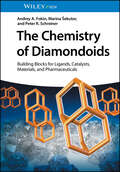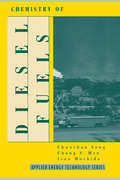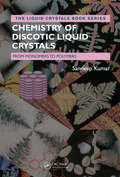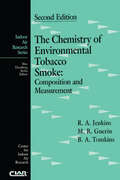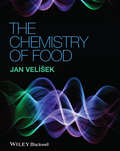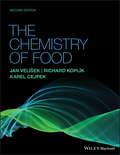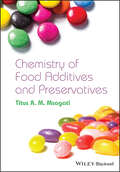- Table View
- List View
Chemistry and Technology of Honey Production (SpringerBriefs in Molecular Science)
by Ettore BaglioThis Brief explains and discusses honey and its production from a chemical perspective. It outlines why honey is a special and unique food, being produced by bees from the nectar of plants or from secretions of living parts of plants. Although glucose and fructose are the main constituents of honey, its overall composition is far from being simple or uniform: other substances such as organic acids, enzymes, or minerals are found in varying amounts. In this Brief, the author addresses the factors that influence the composition of the honey as well as the consequences that the composition has on properties such as color, crystallization, density, viscosity, or the refractive index. This Brief also introduces some of the most commonly used quality parameters for the determination of ageing and/or overheating: 5-hydroxymethylfurfural (HMF) and diastase. Other recently proposed constituents for quality parameters are also mentioned, e. g. 1,2 dicarbonyl compounds (3 deoxyglucosone, methylglyoxal, glyoxal) and furosine, also named 2-furoylmethyl lysine.
Chemistry and Technology of Lubricants
by Malcolm F. Fox Stefan T. Orszulik Roy M. Mortier"Chemistry and Technology of Lubricants" describes the chemistry and technology of base oils, additives and applications of liquid lubricants. This Third Edition reflects how the chemistry and technology of lubricants has developed since the First Edition was published in 1992. The acceleration of performance development in the past 35 years has been as significant as in the previous century: Refinery processes have become more precise in defining the physical and chemical properties of higher quality mineral base oils. New and existing additives have improved performance through enhanced understanding of their action. Specification and testing of lubricants has become more focused and rigorous. "Chemistry and Technology of Lubricants" is directed principally at those working in the lubricants industry as well as individuals working within academia seeking a chemist's viewpoint of lubrication. It is also of value to engineers and technologists requiring a more fundamental understanding of the subject.
Chemistry and Technology of Soft Drinks and Fruit Juices
by Philip R. AshurstSoft drinks and fruit juices are produced in almost every country in the world and their availability is remarkable. From the largest cities to some of the remotest villages, soft drinks are available in a variety of flavours and packaging. Over the last decade, soft drinks and fruit juices have been the subject of criticism by the health community and there is considerable pressure on beverage manufacturers to reduce, or even remove, the sugar content of these products. Chemistry and Technology of Soft Drinks and Fruit Juices, Third Edition provides an overview of the chemistry and technology of soft drinks and fruit juices, covering ingredients, processing, microbiology, traceability and packaging as well as global market trends. This fully revised edition now includes chapters on topics that have become prominent in the industry since publication of the previous edition namely: water use and treatment, and microbiology technologies. The book is directed at graduates in food science, chemistry or microbiology entering production, quality control, new product development or marketing in the beverage industry or in companies supplying ingredients or packaging materials to the beverage industry.
Chemistry as a Game of Molecular Construction
by Sason Shaik Racheli Ben-Knaz Wakshlak Roald Hoffmann Dina A. Sharon Usharani DandamudiThe proposed textbook takes the students into a fascinating journey that shows the universal aspect of chemistry: Chemistry is the window given to mankind to glimpse into his material-chemical essence and come to terms with its limitations. In the introductory chapter/lecture, the textbook discusses the connection between the "chemical matter" and love, sex, depression, addiction--all the properties we call "human". As we are made of chemical matter, this chapter makes a point why knowledge of chemistry is so essential to mankind. This preamble is followed by about 14 short chapters/lectures, which introduce chemistry as molecule building process, like a game of Lego.
Chemistry Education
by Elena Serrano-Torregrosa Javier Garc?a-Mart?nez Peter W. AtkinsThis comprehensive collection of top-level contributions provides a thorough review of the vibrant field of chemistry education. Highly-experienced chemistry professors and education experts cover the latest developments in chemistry learning and teaching, as well as the pivotal role of chemistry for shaping a more sustainable future. Adopting a practice-oriented approach, the current challenges and opportunities posed by chemistry education are critically discussed, highlighting the pitfalls that can occur in teaching chemistry and how to circumvent them. The main topics discussed include best practices, project-based education, blended learning and the role of technology, including e-learning, and science visualization. Hands-on recommendations on how to optimally implement innovative strategies of teaching chemistry at university and high-school levels make this book an essential resource for anybody interested in either teaching or learning chemistry more effectively, from experience chemistry professors to secondary school teachers, from educators with no formal training in didactics to frustrated chemistry students.
Chemistry Education and Sustainability in the Global Age
by Chin-Cheng Chou Hsiao-Lin Tuan Hsin-Kai Wu Jing-Wen Lin Mei-Hung ChiuThis edited volume of papers from the twenty first International Conference on Chemical Education attests to our rapidly changing understanding of the chemistry itself as well as to the potentially enormous material changes in how it might be taught in the future. Covering the full range of appropriate topics, the book features work exploring themes as various as e-learning and innovations in instruction, and micro-scale lab chemistry. In sum, the 29 articles published in these pages focus the reader's attention on ways to raise the quality of chemistry teaching and learning, promoting the public understanding of chemistry, deploying innovative technology in pedagogy practice and research, and the value of chemistry as a tool for highlighting sustainability issues in the global community. Thus the ambitious dual aim achieved in these pages is on the one hand to foster improvements in the leaching and communication of chemistry--whether to students or the public, and secondly to promote advances in our broader understanding of the subject that will have positive knock-on effects on the world's citizens and environment. In doing so, the book addresses (as did the conference) the neglect suffered in the chemistry classroom by issues connected to globalization, even as it outlines ways to bring the subject alive in the classroom through the use of innovative technologies.
Chemistry for Cooks: An Introduction to the Science of Cooking
by Sandra C. GreerA fun approach to teaching science that uses cooking to demonstrate principles of chemistry for undergraduate students who are not science majors, high school students, culinary students, and home cooks.How does an armload of groceries turn into a culinary masterpiece? In this highly accessible and informative text, Sandra C. Greer takes students into the kitchen to show how chemistry—with a dash of biology and physics—explains what happens when we cook. Chemistry for Cooks provides all the background material necessary for nonscientists to understand essential chemical processes and to see cooking as an enjoyable application of science. Greer uses a variety of practical examples, including recipes, to instruct readers on the molecular structure of food, the chemical reactions used in cooking to change the nature of food, and the essentials of nutrition and taste. She also offers kitchen hints and exercises based on the material in each chapter, plus do-it-yourself projects to encourage exploration of the chemistry that takes place when we cook food. FeaturesPerfect for science courses aimed at non–science majors: does not require prior knowledge of chemistry, physics, or biologyEqually useful for general readers, home and professional cooks, and culinary studentsTopics include what matter is made of, how the structure of matter is altered by heat, how we treat food in order to change its microscopic structure, why particular procedures or methods are used in the kitchen, and how to think critically about various cooking methodsA reference section at the end of each chapter points readers to resources for further studyAdditional online resources include a solutions manual, a sample syllabus, and PowerPoint slides of all tables and figures
Chemistry for Sustainable Development in Africa
by Ameenah Gurib-Fakim Jacobus Nicolaas EloffChemistry for Sustainable Development in Africa gives an insight into current Chemical research in Africa. It is edited and written by distinguished African scientists and includes contributions from Chemists from Northern, Southern, Western, Eastern, Central and Island state African Countries. The core themes embrace the most pressing issues of our time, including Environmental Chemistry, Renewable Energies, Health and Human Well-Being, Food and Nutrition, and Bioprospecting and Commercial Development. This book is invaluable for teaching and research institutes in Africa and worldwide, private sector entities dealing with natural products from Africa, as well as policy and decision-making bodies and non-governmental organizations.
Chemistry in Microelectronics
by Yannick Le TiecMicroelectronics is a complex world where many sciences need to collaborate to create nano-objects: we need expertise in electronics, microelectronics, physics, optics and mechanics also crossing into chemistry, electrochemistry, as well as biology, biochemistry and medicine. Chemistry is involved in many fields from materials, chemicals, gases, liquids or salts, the basics of reactions and equilibrium, to the optimized cleaning of surfaces and selective etching of specific layers. In addition, over recent decades, the size of the transistors has been drastically reduced while the functionality of circuits has increased. This book consists of five chapters covering the chemicals and sequences used in processing, from cleaning to etching, the role and impact of their purity, along with the materials used in “Front End Of the Line” which corresponds to the heart and performance of individual transistors, then moving on to the “Back End Of the Line” which is related to the interconnection of all the transistors. Finally, the need for specific functionalization also requires key knowledge on surface treatments and chemical management to allow new applications. Contents 1. Chemistry in the “Front End of the Line” (FEOL): Deposits, Gate Stacks, Epitaxy and Contacts, François Martin, Jean-Michel Hartmann, Véronique Carron and Yannick Le Tiec. 2. Chemistry in Interconnects, Vincent Jousseaume, Paul-Henri Haumesser, Carole Pernel, Jeffery Butterbaugh, Sylvain Maîtrejean and Didier Louis. 3. The Chemistry of Wet Surface Preparation: Cleaning, Etching and Drying, Yannick Le Tiec and Martin Knotter. 4. The Use and Management of Chemical Fluids in Microelectronics, Christiane Gottschalk, Kevin Mclaughlin, Julie Cren, Catherine Peyne and Patrick Valenti. 5. Surface Functionalization for Micro- and Nanosystems: Application to Biosensors, Antoine Hoang, Gilles Marchand, Guillaume Nonglaton, Isabelle Texier-Nogues and Francoise Vinet. About the Authors Yannick Le Tiec is a technical expert at CEA-Leti, Minatec since 2002. He is a CEA-Leti assignee at IBM, Albany (NY) to develop the advanced 14 nm CMOS node and the FDSOI technology. He held different technical positions from the advanced 300 mm SOI CMOS pilot line to different assignments within SOITEC for advanced wafer development and later within INES to optimize solar cell ramp-up and yield. He has been part of the ITRS Front End technical working group at ITRS since 2008.
The Chemistry Knowledge for Firefighters
by Torsten SchmiermundChemical facts taught in firefighting training courses are often "isolated facts." In the book, these facts are integrated into an overall chemical-physical concept. Backgrounds are illuminated, and connections can be recognized. The overall understanding is facilitated, tactical measures for the operation become "logical".This book is a translation of the original German 1st edition Das Chemiewissen für die Feuerwehr by Torsten Schmiermund, published by Springer-Verlag GmbH Germany, part of Springer Nature in 2019. The translation was done with the help of artificial intelligence (machine translation by the service DeepL.com). A subsequent human revision was done primarily in terms of content, so that the book will read stylistically differently from a conventional translation. Springer Nature works continuously to further the development of tools for the production of books and on the related technologies to support the authors.
Chemistry Lessons
by Meredith GoldsteinFrom advice columnist Meredith Goldstein, a dazzling, romantic, and emotionally resonant YA debut about a teen science whiz in Cambridge, Massachusetts, who tries to crack the chemical equation for lasting love and instead wreaks havoc on herself and the boys in her life. For seventeen-year-old Maya, the equation for happiness is simple: a dream internship at MIT + two new science nerd friends + a perfect boyfriend = one amazing summer. Then Whit dumps her out of the blue. Maya is miserable until she discovers that her scientist mother, before she died, was conducting research on manipulating pheromones to enhance human attraction. If Maya can finish her mother’s work, maybe she can get Whit back. But when her experiment creates chaos in her love life, she realizes that maybe love and loss can’t be understood using the scientific method. Can she learn to trust the unmeasurables of love and attraction instead?
Chemistry Made Simple: A Complete Introduction to the Basic Building Blocks of Matter (Made Simple)
by John T. Moore Ed.D.See the world, one molecule at a time. Chemistry helps us understand not only the world around us, but also our own bodies. CHEMISTRY MADE SIMPLE makes it fun. Each chapter has practice problems with complete solutions that reinforce learning. A glossary of chemical terms, the modern periodic table, and detailed illustrations throughout make this the best introduction to one of the most studied of all sciences.Topics covered include: *the Scientific Method *the structure and properties of matter*compounds *laws of chemistry*gases, liquids, and solids *solutions *electrochemistry*the atmosphere*biochemistry*organic chemistry *nuclear chemistry*energy *the environment Look for these Made Simple titlesAccounting Made SimpleArithmetic Made SimpleAstronomy Made SimpleBiology Made SimpleBookkeeping Made SimpleBusiness Letters Made SimpleEarth Science Made SimpleEnglish Made SimpleFrench Made SimpleGerman Made SimpleIngles Hecho Facil Investing Made SimpleItalian Made SimpleLatin Made SimpleLearning English Made SimpleMathematics Made SimpleThe Perfect Business Plan Made SimplePhilosophy Made SimplePhysics Made SimplePsychology Made SimpleSign Language Made SimpleSpelling Made SimpleStatistics Made SimpleYour Small Business Made Simplewww.broadwaybooks.com
The Chemistry of Bio-based Polymers
by Johannes Karl FinkAn exhaustive and timely overview of renewable polymers from a respected chemist and successful author The recent explosion of interdisciplinary research has fragmented the knowledge base surrounding renewable polymers. The Chemistry of Bio-based Polymers brings together, in one volume, the research and work of Professor Johannes Fink, focusing on biopolymers that can be synthesized from renewable polymers. After introducing general aspects of the field, the book’s subsequent chapters examine the chemistry of biodegradable polymeric types sorted by their chemical compounds, including the synthesis of low molecular compounds. Various categories of biopolymers are detailed including vinyl-based polymers, acid and lactone polymers, ester and amide polymers, carbohydrate-related polymers and others. Procedures for the preparation of biopolymers and biodegradable nanocomposites are arranged by chemical methods and in vitro biological methods, with discussion of the issue of “plastics from bacteria.” The factors influencing the degradation and biodegradation of polymers used in food packaging, exposed to various environments, are detailed at length. The book covers the medical applications of bio-based polymers, concentrating on controlled drug delivery, temporary prostheses, and scaffolds for tissue engineering. Professor Fink also addresses renewable resources for fabricating biofuels and argues for localized biorefineries, as biomass feedstocks are more efficiently handled locally. Audience The Chemistry of Bio-based Polymers will be read by chemists, polymer and materials scientists, chemical, bio-based, and biomedical engineers, agricultural and environmental faculty and all those who work in the bioeconomy area. This book will be critical for engineers in a number of industries including food packaging, medical devices, personal care, fuels, auto, and construction.
The Chemistry of Bio-based Polymers
by Johannes Karl FinkThe recent explosion of interdisciplinary research has fragmented the knowledge base surrounding renewable polymers. The Chemistry of Bio-based Polymers 2nd edition brings together, in one volume, the research and work of Professor Johannes Fink, focusing on biopolymers that can be synthesized from renewable polymers. After introducing general aspects of the field, the book’s subsequent chapters examine the chemistry of biodegradable polymeric types sorted by their chemical compounds, including the synthesis of low molecular compounds. Various categories of biopolymers are detailed including vinyl-based polymers, acid and lactone polymers, ester and amide polymers, carbohydrate-related polymers and others. Procedures for the preparation of biopolymers and biodegradable nanocomposites are arranged by chemical methods and in vitro biological methods, with discussion of the issue of “plastics from bacteria.” The factors influencing the degradation and biodegradation of polymers used in food packaging, exposed to various environments, are detailed at length. The book covers the medical applications of bio-based polymers, concentrating on controlled drug delivery, temporary prostheses, and scaffolds for tissue engineering. Professor Fink also addresses renewable resources for fabricating biofuels and argues for localized biorefineries, as biomass feedstocks are more efficiently handled locally.
Chemistry of Bioconjugates
by Ravin NarainExplores bioconjugate properties and applications of polymers, dendrimers, lipids, nanoparticles, and nanotubesBioconjugation has enabled breakthroughs across many areas of industry and biomedicine. With its emphasis on synthesis, properties and applications, this book enables readers to understand the connection between chemistry and the biological application of bioconjugated materials. Its detailed descriptions of methods make it possible for researchers to fabricate and take full advantage of bioconjugates for a broad range of applications. Moreover, the book sets the foundation for the development of new applications, including assays, imaging, biosensors, drug delivery, and diagnostics.Chemistry of Bioconjugates features contributions from an international team of leading experts and pioneers in the field. These contributions reflect the authors' firsthand laboratory experience as well as a thorough review of the current literature. The book's six sections examine:General methods of bioconjugationPolymer bioconjugatesOrganic nanoparticle-based bioconjugatesInorganic nanomaterial bioconjugates, including metals and metal oxidesCell-based, hydrogel/microgel, and glyco-bioconjugatesCharacterization, physico-(bio)chemical properties, and applications of bioconjugatesThis comprehensive exploration of bioconjugates includes discussions of polymers, dendrimers, lipids, nanoparticles, and nanotubes. References at the end of each chapter serve as a gateway to the most important original research findings and reviews in the field.By drawing together and analyzing all the latest chemical methods and research findings on the physico-chemical and biochemical properties of bioconjugates, Chemistry of Bioconjugates sheds new light on the significance and potential of bioconjugation. The book is recommended for organic and polymer chemists, biochemists, biomaterial scientists, carbohydrate chemists, biophysicists, bioengineers, and drug and gene delivery scientists.
The Chemistry of Cereal Proteins
by Radomir LasztityIn the past decade, since the first edition was published, the study of cereal protein chemistry has grown and changed. New separation techniques have been introduced while the application of achievements of molecular biology and genetic engineering of proteins has progressed dramatically. This new edition includes these advances and updates the chemistry of cereal proteins for all specialists working in theory and practice of cereal grain production and processing.
Chemistry of Dehydrogenation Reactions and Its Applications (Emerging Materials and Technologies)
by Syed Shahabuddin Rama Gaur Nandini MukherjeeThe present book focuses on advancement in the application of heterogeneous catalytic materials for the dehydrogenative synthesis of valuable organic compounds from substrates such as alcohols and simple aliphatic compounds. Several heterogeneous transition metals-based catalytic materials are explored for the synthesis of valuable chemicals for industrial applications. The book provides insight into the application of state-of-the-art technology for energy utilization and clean chemical synthesis. Features: Offers a wide overview of dehydrogenation catalytic chemistry catalyzed by transition metals and their compounds. Helps design novel and more benign and uncomplicated protocols for the synthesis of valuable chemicals from readily available raw materials. Provides deeper insight into the aspect of dehydrogenation reactions for clean chemical synthesis via a cascade process. Summarizes new mechanistic details of dehydrogenation reactions, experimental side development and applications of dehydrogenation techniques. Explores alternative solutions for the assimilation and transportation of clean energy in the form of hydrogen energy utilization. This book is aimed at graduate students and researchers in chemical engineering, chemistry, catalysis, organic synthesis, pharmaceutical chemistry and petrochemistry.
The Chemistry of Diamondoids: Building Blocks for Ligands, Catalysts, Pharmaceuticals, and Materials
by Andrey A. Fokin Marina Sekutor Peter R. SchreinerThe Chemistry of Diamondoids Comprehensive resource on an important and fascinating compound class, covering synthesis, properties, functionalization, and applications in organic synthesis, materials science, and more The Chemistry of Diamondoids gives a state-of-the-art overview of all aspects of diamondoid chemistry, covering nomenclature, natural occurrence, chemical and physical properties, along with synthesis and functionalization of diamondoids as well as their applications as molecular building blocks in organic synthesis, polymer and materials science, nanotechnology, and medicinal chemistry. The book concludes with a perspective towards future developments in the field, thereby drawing attention to areas open for discovery. Written by experts in the field, The Chemistry of Diamondoids includes information on: Naturally occurring diamondoids, their formation, and the role they play in the petroleum industry and in geosciences, plus man-made approaches to prepare them on large scale Growing diamond from diamondoids via seeding, preparation and properties of diamondoid oligomers and doped diamondoids C–H-bond functionalization, a precondition for their use in many applications, and fine-tuning of diamondoid properties by precise cage substitution reactions With its all-encompassing approach, The Chemistry of Diamondoids is a valuable guide for newcomers and researchers in organic chemistry and materials science interested in modern synthetic methods and organic functional materials.
Chemistry of Diesel Fuels
by Chunsham SongThis edited work covers diesel fuel chemistry in a systematic fashion from initial fuel production to the tail pipe exhaust. The chapters are written by leading experts in the research areas of analytical characterization of diesel fuel, fuel production and refining, catalysis in fuel processing, pollution minimization and control, and diesel fuel additives.
Chemistry of Discotic Liquid Crystals: From Monomers to Polymers (Liquid Crystals Book Series)
by Sandeep KumarThe self-contained properties of discotic liquid crystals (DLCs) render them powerful functional materials for many semiconducting device applications and models for energy and charge migration in self-organized dynamic functional soft materials. The past three decades have seen tremendous interest in this area, fueled primarily by the possibility
The Chemistry of Environmental Tobacco Smoke: Composition and Measurement, Second Edition (Indoor Air Research)
by Roger A. Jenkins Bruce Tomkins Michael R. GuerinConsidered the definitive resource in its field, The Chemistry of Environmental Tobacco Smoke: Composition and Measurement compiles observations on the properties of Environmental Tobacco Smoke (ETS) and on the concentrations of its constituents in indoor air. It focuses on common natural indoor environments and environments associated with chronic exposure. The authors -- all renowned experts -- stress both measurement methods and the competing sources of indoor air contaminants commonly attributed to ETS. For the second edition, each chapter has been updated to reflect new studies and up-to-date information.
The Chemistry of Food
by Jan VelisekA core subject in food Science, food chemistry is the study of the chemical composition, processes and interactions of all biological and non-biological components of foods. This book is an English language translation of the author's Czech-language food chemistry textbook. The first half of the book contains an introductory chapter and six chapters dealing with main macro- and micronutrients, and the essential nutritional factors that determine the nutritional and energy value of food raw materials and foods. It includes chapters devoted to amino acids, peptides and proteins, fats and other lipids, carbohydrates, vitamins, mineral substances and water. The second half of the book deals with compounds responsible for odour, taste and colour that determine the sensory quality of food materials and foods. It further includes chapters devoted to antinutritional, toxic and other biologically active substances, food additives and contaminants. Students, teachers and food technologists will find this book an essential reference on detailed information about the changes and reactions that occur during food processing and storage and possibilities how to manage them. Nutritionists and those who are interested in healthy nutrition will find information about nutrients, novel foods, organic foods, nutraceuticals, dietary supplements, antinutritional factors, food additives and contaminants.
The Chemistry of Food
by Jan Velisek Richard Koplik Karel CejpekWiley's landmark food chemistry textbook that provides an all-in-one reference book, revised and updated The revised second edition of The Chemistry of Food provides a comprehensive overview of important compounds constituting of food and raw materials for food production. The authors highlight food’s structural features, chemical reactions, organoleptic properties, nutritional, and toxicological importance. The updated second edition reflects the thousands of new scientific papers concerning food chemistry and related disciplines that have been published since 2012. Recent discoveries deal with existing as well as new food constituents, their origin, reactivity, degradation, reactions with other compounds, organoleptic, biological, and other important properties. The second edition extends and supplements the current knowledge and presents new facts about chemistry, legislation, nutrition, and food safety. The main chapters of the book explore the chemical structure of substances and subchapters examine the properties or uses. This important resource: • Offers in a single volume an updated text dealing with food chemistry • Contains complete and fully up-to-date information on food chemistry, from structural features to applications • Features several visual aids including reaction schemes, diagrams and tables, and nearly 2,000 chemical structures • Written by internationally recognized authors on food chemistry Written for upper-level students, lecturers, researchers and the food industry, the revised second edition of The Chemistry of Food is a quick reference for almost anything food-related as pertains to its chemical properties and applications.
The Chemistry of Food Additives and Preservatives
by Titus A. MsagatiThe Chemistry of Food Additives and Preservatives is an up-to-date reference guide on the range of different types of additives (both natural and synthetic) used in the food industry today. It looks at the processes involved in inputting additives and preservatives to foods, and the mechanisms and methods used. The book contains full details about the chemistry of each major class of food additive, showing the reader not just what kind of additives are used and what their functions are, but also how they work and how they can have multiple functionalities. In addition, this book covers numerous new additives currently being introduced, and an explanation of how the quality of these is ascertained and how consumer safety is ensured.
Chemistry of Fossil Fuels and Biofuels
by Harold SchobertFocusing on today's major fuel resources – ethanol, biodiesel, wood, natural gas, petroleum products and coal – this book discusses the formation, composition and properties of the fuels, and the ways in which they are processed for commercial use. It examines the origin of fuels through natural processes such as photosynthesis and the geological transformation of ancient plant material; the relationships between their composition, molecular structures and physical properties; and the various processes by which they are converted or refined into the fuel products appearing on today's market. Fundamental chemical aspects such as catalysis and the behaviour of reactive intermediates are presented and global warming and anthropogenic carbon dioxide emissions are also discussed. The book is ideal for graduate students in energy engineering, chemical engineering, mechanical engineering and chemistry, as well as professional scientists and engineers.
